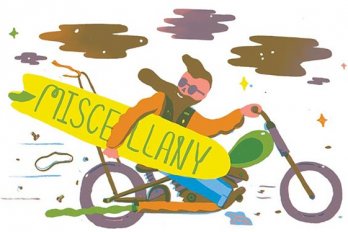“So now I’d be coming up from the helicopter,” says Wendell Uglene. “I’ll try to get to the surface, the suit’s going to take me up, and I’ll inflate.” His voice echoes in Mustang Survival’s test pool room, at the company’s headquarters in Burnaby, British Columbia. He is strapped in to a two-metre-wide aluminum wheel called the BEAST (buoyancy egress assessment survival trainer), which is partly submerged in the small cubic pool, and his gravelly voice sounds squeaky due to the tight neck seal of his V4 flight commander suit. The young fifty-year-old’s shaggy silver hair is tucked in to the black neoprene hood assembly, his wire frame glasses—which would compromise the seal—stashed away.
On the count of three, mechanical engineer Sara Tahermaram rotates the BEAST into the water. Once upside down, Uglene egresses from the oversized hamster wheel and inflates his suit as he breaks the surface. Within seconds, lobes of neon green fabric inflate across his back and encircle his chest. He splashes around, initiating critical survival procedures; he gets his spray hood on; he gets his mitts on. “Done!” he shouts. Tahermaram checks her stopwatch: “One minute, one second.” Uglene looks up at her eagerly. The water suctions against the suit’s waterproof shell, making it bunch up like the skin of a Shar-Pei. “What’s next? ” he asks.
Uglene is Mustang’s manager of research and technology. After six weeks of design and development, his team is testing two prototypes for a proposed contract with a consortium of six companies to supply helicopter passenger suits for oil rig workers off the East Coast. The first is Uglene’s V4 getup, in a lurid neon green for superior visibility on the water; it’s a variant of the V3, 1,500 of which Royal Dutch Shell uses in Alaska. The second is the V5, a sleek, two-tone high-concept model. The survival, or immersion, suits are among the most sophisticated items in the company’s catalogue: “Our most technologically advanced marriage of inflation and thermal and breathing protection,” says Uglene.
According to mythology, the Pillars of Hercules at the Strait of Gibraltar, which marked the edge of the known world, were etched with the motto “Ne Plus Ultra,” cautioning sailors to venture no farther. Mustang urges its clients to go farther but dress appropriately. Its 3,000 products are designed to protect the human body from pretty much any hazard Mother Nature throws its way: immersion, cold, excessive G-forces, a four-second fireball. “Our garments have a function,” says Uglene, “and that’s to save your life.”
Founded in 1967 in Vancouver’s Gastown, Mustang got its start making Floater Coats, foam-lined, full-sleeved life jackets. (In 1968, John Wayne rang up inventor Irv Davies and said, “I’ve got to get one of those damn jackets. A buddy of mine got one here, and it’s the greatest.”) Since then, it has moved on to professional, military, and recreational survival clothing, with some 400 employees at its head office and two manufacturing plants, one in Burnaby and one in West Virginia. Representatives will not discuss sales and revenues, but according to a former employee the company sold roughly $40 million in 2008, although that figure could be higher. Clients include the United States Navy, the US Air Force, the US Coast Guard, and NASA. In 2013, it was acquired by the Safariland Group, an American manufacturer of protective equipment for law enforcement and security agencies.
Mustang’s in-house lab, which adjoins its Burnaby production floor, presents like Q Branch from the James Bond movies crossed with Project Runway for six-foot-three, square-jawed mannequins. The 15,000-square-foot facility houses a prototyping shop (“We bond raw materials, fry them, weld them, and turn them into a product,” says Uglene); the test pool; and a heat stress chamber, affectionately called “the bakery.” Various devices measure the materials’ insulation, thermal heat loss, and breathability. Uglene speaks about one, called the “sweating hot plate,” with reverence; it’s very sophisticated.
A survivalist since childhood, he grew up in Kamloops in the BC interior, and spent his youth in the bush hunting and fishing before moving to Vancouver to study applied physics and engineering. He started working at Mustang in 1992. Twenty-two years later, his closets at home are full of survival suits and related prototypes—“I’ve got everything from colourful and fancy to cool looking to camo stealth”—including one designed to facilitate escape from a submarine at up to 200 metres. He can’t say the gear has ever saved his life, but it has saved two friends of his, one a fisherman, the other a pilot. As an avid outdoorsman with a strong streak of self-sufficiency, he offers this advice: “Never be comfortable with the water.”
Canada is surrounded by the world’s longest coastline, and more than 20 percent of the population lives in coastal communities, which takes a toll. In the ’90s alone, roughly 6,000 Canadians died in water-related incidents. According to Red Cross estimates, about 2,000 of those were cold-water deaths. Of the occupations supervised by WorkSafeBC, fishing is the most deadly; fatality rates across the country are consistently high, at around fourteen a year. At the same time, with the discovery of new, ever more remote drilling sites, offshore oil production in Atlantic Canada is forecast to remain steady through 2024. In 2013, Imperial Oil proposed a plan to drill in the Beaufort Sea, while shipping traffic in the Arctic Ocean has increased by more than a third, due in part to the growing number of cruises. “We’re colder than most countries, foggier, and more remote,” says Uglene. “You’re on your own out there until somebody shows up.”
When it comes to cold water, Mother Nature is unforgiving. Several things happen when you’re suddenly immersed in it, none of them good. To begin with, your body takes what physiologists call a “deep inspiratory gasp.” You can drown on the spot if you’re submerged, but even on the surface you lose dexterity in minutes, and the temperature reduces your ability to hold your breath by 25 to 50 percent. You go from breathing twelve times a minute to sixty-six. Your heart rate accelerates to the point where if you’re in poor shape you have a heart attack. If you try to swim for help, you become exhausted in minutes. All the while, the water is draining your body heat until your blood cools and thickens and your chilled heart can no longer pump it. It doesn’t even have to be that cold; 15° is the threshold below which shock and swimming failure turn deadly. “The three oceans here all have water below 15°,” says Chris Brooks, a survival consultant and former head of the Canadian Naval and Air Force Medical Services. “So we need protection.”
For much of the twentieth century, experts chalked up deaths in water to drowning and exposure. That changed in the wake of World War II when they began to examine how 20,000 to 30,000 Royal Navy officers and seamen died after escaping from their ships during the Battle of the Atlantic. “Until 1945, it was considered an occupational hazard, or fate,” says Brooks, “but we’ve managed to get around that. We have life jackets now, and survival suits. We’ve made more progress in the past fifty years than in the previous five million.”
By the 1970s, the Alaskan commercial fishing fleet had started to employ immersion suits after stories about how they saved lives began spreading around the docks. “That also helped to dispel this myth of the sea,” says Jerry Dzugan, director of the Alaska Marine Safety Education Association, “that if your boat goes down you’re going to die, that the sea gives and it takes. That old culture started to erode, largely because of immersion suits. Hundreds have been saved by them.”
The Canadian offshore oil and gas industry spurred innovation in second-generation survival suits after eighty-four men lost their lives when the Ocean Ranger rig sank in 1982. “Afterwards, the decision was made that for a northern country with a lot of arctic water, the standards and products available are not of high enough quality,” says Dave Comeau, vice-president of operations at Falck Safety Services in Dartmouth, Nova Scotia. The ensuing Canadian regulations for survival suits were the first of their kind, and they have since undergone several iterations, the latest published in 2012.
“This report is what I ultimately have to meet,” says Uglene. He has changed out of the V4 flight commander suit and into his usual work attire, black jeans and a quick-dry river shirt. He lifts a big sheaf of paper from his desk, which is littered with the original V5 sketch and half-finished experiments using electronic fibres and vacuum-packed insulation mitts. The title page reads, Helicopter Passenger Transportation Suit Systems, and the next seventy-five pages detail such minutiae as thread tensile and seam strength, and gas permeability of fabrics. Two pages are dedicated to colour codes and visibility alone. “It tells you everything crazy people like us do to make a suit legal,” he says with a touch of pride.
On March 12, 2009, a Sikorsky S-92A helicopter en route to Hibernia, Canada’s largest offshore oil field, ditched in the Atlantic Ocean fifty-five kilometres southeast of St. John’s. Uglene heard about the crash on morning television and tracked the story on the news all day. “As an expert, you know it’s not good,” he says. “Every minute going by is not a good minute. You wish you could just stop time.” Of the eighteen people on board, only Robert Decker, then twenty-eight, was rescued. He was wearing a survival suit, but it had leaked. By the time he reached the hospital, after almost ninety minutes in the 0° water, his body temperature was 29.8°.
In his harrowing testimony during an inquiry conducted by Commissioner Robert Wells, Decker recalled a routine flight (“Shortly after the helicopter took off, I fell asleep”), which went awry when the pilot announced that they were heading for the closest land and told everyone to put on their survival suits. As they plunged nose down toward the ocean, he heard the pilot call, “Ditching, ditching, ditching!” Decker blacked out on impact and regained consciousness as the helicopter sped toward the ocean floor, full of water and eerily lit up by the water-activated lights on the other passengers’ suits.
He credits many factors for his survival. Chief among them, he worked as a sailing instructor in the types of waters the helicopter crashed into. His instincts under conditions that might otherwise kill a person were well honed, and he did have help. After he escaped his four-point harness and exited through a broken window, his suit carried him to the surface. He was also plain lucky. The helicopter was going eighty-five knots when it hit the water at G-forces more than twenty times that of gravity. “It was a non-survivable crash,” says Uglene. “That he lived is amazing. It means the suits are doing their job.”
Still, Decker’s suit, made by one of Mustang’s competitors, had shortcomings, which Wells flagged in his final report. “I knew [the crash] meant the standard was probably going to be revisited,” says Uglene. Transport Canada and the Canadian General Standards Board reviewed the helicopter passenger suit regulations, which had not been updated since 1999, and Uglene was asked to join the working group as an expert. “Being asked to serve on the standard was quite an honour,” he says, “because it meant somebody thought my work had stood the test of time. But when I grasped the magnitude of what we had to do…” The 2012 standards, which he and his team were now designing the V4 and V5 suits to meet, would be the most demanding ever. The biggest changes involve more strenuous testing in choppy conditions. “The next generation,” he says, “will be better and safer, no matter who makes them.”
In October, Mustang Survival was still awaiting a decision on the East Coast contract. The evaluation was dragging out, which Uglene took as a sign that the race was tight and might end in the company’s favour. As time passed, the stress increased. He was both highly invested (“I’m going to cry if we lose. It’s that emotionally taxing”) and calmly removed (“History has said we could lose this one, and there will be another opportunity”). One day, he forwarded a link to a story on the crash of the icebreaker Amundsen’s helicopter in the Canadian Arctic. All three men on board were wearing survival suits but died while waiting to be rescued. “Why we do what we do…and why we can always make safer systems for those who risk their lives,” he wrote. “This one likely to be an inquiry.” For people in this line of work, there is always another death that, just maybe, could have been prevented—and other lives to save.
This appeared in the January/February 2014 issue.




